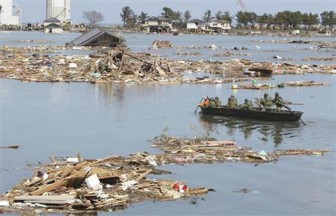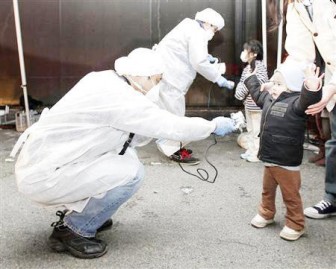FUKUSHIMA, Japan (Reuters) – Japan battled to contain a radiation leak at an earthquake-crippled nuclear plant today, but faced a fresh threat with the failure of the cooling system in a second reactor.

Operator TEPCO said it was preparing to release some steam to relieve pressure in the No.3 reactor at the plant 240 km (150 miles) north of Tokyo — which would release a small amount of radiation — following an explosion and leak yesterday in the facility’s No. 1 reactor.
As strong aftershocks continued to shake Japan’s main island the desperate search for survivors from Friday massive earthquake and tsunami continued, and the death toll was expected to rise.
Thousands spent another freezing night huddled over heaters in emergency shelters along the northeastern coast, a scene of devastation after the 8.9 magnitude quake sent a 10-metre (33-foot) wave surging through towns and cities.
Kyodo news agency said the number of dead or unaccounted for as a result of the quake and tsunami was expected to exceed 1,800. It also reported there had been no contact with around 10,000 people in one small town, more than half its population.
The government insisted radiation levels were low following yesterday’s explosion, saying the blast had not affected the reactor core container, and the International Atomic Energy Agency (IAEA) said it had been told by Japan that levels “have been observed to lessen in recent hours”.
But Japan’s nuclear safety agency said the number of people exposed to radiation from the Fukushima Daiichi plant could reach 160. Workers in protective clothing were scanning people arriving at evacuation centres for radioactive exposure.
Around 140,000 people had been evacuated from areas near the plant and another nuclear facility nearby, while authorities prepared to distribute iodine to people in the vicinity to protect them from radioactive exposure.
“There is radiation leaking out, and since the possibility (of being exposed) is high, it’s quite scary,” said Masanori Ono, 17, standing in line yesterday to be scanned for radiation at an evacuation centre in Fukushima prefecture.

Before news of the problem with reactor No. 3, the nuclear safety agency said the plant accident was less serious than both the Three Mile Island accident in 1979 and the 1986 Chernobyl nuclear disaster.
An official at the agency said it has rated the incident a 4 according to the International Nuclear and Radiological Event Scale (INES). Three Mile Island was rated 5 while Chernobyl was rated 7 on the 1 to 7 scale, the official said.
Devastated coastline
Along the northeast coast, rescue workers searched through the rubble of destroyed buildings, cars and boats, looking for survivors in hardest-hit areas such as the city of Sendai, 300 km (180 miles) northeast of Tokyo.
Aerial footage showed buildings, trains and even light aircraft strewn like children’s toys after powerful walls of seawater swamped areas around Sendai.
In Iwanuma, not far from Sendai, nurses and doctors were rescued on Saturday after spelling S.O.S. on the rooftop of a partially submerged hospital, one of many desperate scenes. In cities and towns, worried relatives checked information boards on survivors at evacuation centres. Dazed residents hoarded water and huddled in makeshift shelters in near-freezing temperatures.
“All the shops are closed, this is one of the few still open. I came to buy and stock up on diapers, drinking water and food,” Kunio Iwatsuki, 68, told Reuters in Mito city, where residents queued outside a damaged supermarket for supplies.
Japan’s Kyodo news agency said about 300,000 people were evacuated nationwide, many seeking refuge in shelters, wrapped in blankets, some clutching each other sobbing.
It said 5.5 million people were without power, while 3,400 buildings had either been destroyed or damaged. Four trains were unaccounted for after the tsunami.
In Tokyo, the usually bustling central districts were deserted last night, and the few in bars and restaurants were glued to television coverage of the disaster.
“Even in the bar we kept staring at the news,” said Kasumi, a 26-year-old woman meeting a friend for a drink in the central district of Akasaka. “I looked at the tsunami swallowing houses and it seemed like a film.”
No repeat of
chernobyl – experts
The blast at the nuclear plant raised fears of a meltdown at the power facility.
Experts had earlier said Japan should not expect a repeat of Chernobyl. They said pictures of mist above the plant suggested only small amounts of radiation had been expelled as part of measures to ensure its stability, far from the radioactive clouds Chernobyl spewed out 25 years ago.
Plant operator TEPCO has had a rocky past in an industry plagued by scandal. In 2002, the president of the country’s largest power utility was forced to resign along with four other senior executives, taking responsibility for suspected falsification of nuclear plant safety records.
Many Japanese flooded social networking sites with worries about the plant.
“I can’t trust TEPCO,” said a person with the handlename Tanuki Atsushi on mixi, the Japanese social networking site.
The earthquake and tsunami, and now the radiation leak, present Japan’s government with its biggest challenge in a generation.




